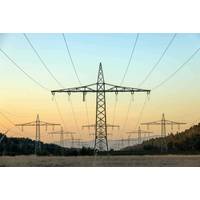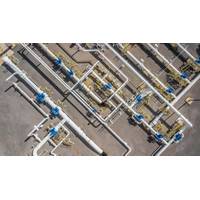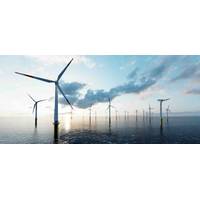Energy operator warns of emerging risks to UK gas supply as demand declines slowly
The energy operator in Britain warned on Wednesday of possible shortages during the coldest months. In its first assessment of gas supply security since being established last January, the National Energy System Operator stated that while overall demand for gas will decrease as Britain decarbonises it will be slower at peak times. This could pose a risk if progress in cutting emissions stagnates or if major infrastructure is faulty. The report, which is a look ahead at winters 2030/31…
Made in Nigeria: Africa's drive to become a solar superpower
In pink overalls they pack the tested products to be shipped from the Salpha Energy solar assembly plant near Calabar, West Africa. It's not happening at home anymore. Salpha Energy, which began in 2017, has produced solar power systems for over two million Nigerian households and businesses. It aims to produce up to 300,000. Salpha Energy is part and parcel of the green leadership that Africans attending the U.N. COP30 Climate Summit in Brazil want to promote and showcase. Carlos Lopes is the special envoy of the COP30 Presidency for Africa.
Ukraine increases imports of US Liquefied Natural Gas via Poland during heating season
Naftogaz, the Ukrainian state-owned oil and gas company, said it would increase imports of U.S. Liquefied Natural Gas through Polish firm Orlen WA as well as U.S. Partners to ensure supply for the winter amid continued Russian attacks on the energy systems. In a press release, CEO Serhiy Koretskyi stated that the imports will total at least 30 million cubic metres. Koretskyi stated that "we will sign the contract soon with credit leverage and insurance instruments." The agreement was signed at a transatlantic conference on energy in Athens.
Sponsored: Energy and Finance Chiefs Call for Sound Policy, Stable Frameworks at ADIPEC

Global finance leaders discuss the new era of energy investment defined by pragmatism, diversification and strategic capital allocation Industry leaders urge fundamentals-based planning amid global volatility, with stable, sound and clear policy frameworks identified as key investment landscape criteria Liquefied natural gas, methane and carbon reduction innovations and emerging markets identified as key investment frontiers Organisations whose speakers shared finance insights at ADIPEC 2025 included Moeve…
Sponsored: Energy Sector Urged to Scale AI Adoption at ADIPEC

Day two's theme 'The Technology Leap: Redefining Energy Leadership' underscored how strategic AI adoption and digital innovation are reshaping energy leadership, with industry voices calling for coordinated investment to unlock transformation at speed and scale Experts debated AI’s role in boosting efficiency, enhancing resilience and unlocking investment while addressing the balance between AI’s potential and its impact on energy demand Key speakers included Jack Hidary CEO, SandboxAQ; Dr.
Sponsored: Policy, AI, and Capital Take Center Stage at ADIPEC 2025

ADIPEC 2025 kicks off in Abu Dhabi with a powerful message from Dr. Sultan Al Jaber for a balanced and inclusive approach to meeting energy demand, built on reinforcement, not replacement. Opening addresses and high-level sessions featuring CEOs and ministers spotlighted the importance of embracing all energy sources, all technologies, and all systems that enhance energy resilience and provide the world with prosperity for all. Day 1 highlights included discussions on the convergence of energy and artificial intelligence…
Vestas' operating profit for the third quarter of 2013 exceeds expectations
Vestas, a manufacturer of wind turbines, reported a third-quarter operating result above expectations on Tuesday. This was driven by a good performance in its onshore operations. The stronger-than-expected result suggests Vestas is successfully executing a turnaround after years of losses, managing to pass on higher costs to customers and improve profitability even as the wider wind industry faces severe headwinds. The Danish company announced a 77% increase in operating profit from July to September before one-offs…
Honda Motors acquires a stake in India's OMC Power for the development of clean energy batteries
Honda Motor, a Japanese automaker, has acquired an equity stake in India's OMC Power. The company is backed by Mitsui & Co. and Chubu Electric Power. Honda did not disclose the exact size of its equity stake in India's clean energy sector. This will be Honda's debut foray. Distributed energy systems can power smaller sites or areas at a lower scale. They can be connected to the grid or disconnected from it. OMC Power has more than 500 renewable power plants in North and Central India.
McKinsey: Fossil Fuels will dominate the global energy usage beyond 2050

According to a McKinsey study, oil, coal and gas will dominate the global energy mix long after 2050. This is because the demand for electricity continues to grow faster than the transition to renewables. The continued use of fossil fuels is a major obstacle to reaching global climate targets. The report states that the main reason for the increase in electricity demand is a 20-40% projected rise from the building and industry sectors by 2050. North American data centres are seen as the major contributors. Natural gas use for electricity production is expected to increase significantly.
Analysts say that China has set a renewable energy goal which it can easily exceed.

The climate goals that China made public on Tuesday promise to continue expanding renewable energy. It has done so at an accelerated pace. However, there is no commitment from China to increase its share of power generation or reduce coal. In announcing China's first goals for carbon reduction, President Xi Jinping stated that China's wind and solar energy capacity would be increased six-fold from the levels of 2020 to 3,600 gigawatts in 2035. Analysts say that China's tendency to set goals they know it can achieve is evident in its achievement of the 1…
EU Targets Power Grid Bottlenecks to Lower Prices, Improve Security

The European Union will prioritise fixing eight power grid bottlenecks, the Commission President said on Wednesday, in an effort to lower the bloc's uncompetitive energy prices and improve energy security."I am presenting today a new initiative called Energy Highways. We have identified eight critical bottlenecks in our energy infrastructure. From the Oresund Strait to the Sicilian Canal," European Commission President Ursula von der Leyen said in her State of the Union address…
German industry lobby warns energy transition could cost 5.4 trillion euros by 2049
The German Chambers of Industry and Commerce said that the current German energy transition strategy would cost up to 5.4 trillion euro ($6.3 trillion) in 2049. This could be a heavy burden on businesses and households, and reduce their competitiveness. Berlin wants to achieve climate neutrality by 2045 by covering 80% of its energy needs with renewable sources by 2030. Electricity prices are among the highest in Europe despite the strong growth of wind and solar power in recent years. With the current policy the energy transition will not succeed.
Russia Strikes Ukrainian Gas Interconnector

Russia has struck a gas pumping station in Ukraine's southern Odesa region used in a scheme to import LNG from the U.S. and Azerbaijan, undermining preparations for winter, Ukrainian officials said on Wednesday.President Volodymyr Zelenskiy said the gas infrastructure had been attacked in the village of Novosilske on the border with Romania, where the Orlovka interconnector, through which Ukraine receives gas via the Transbalkan route, is located."This was a deliberate blow to our preparations for the heating season…
Sunnova sells part of its solar panel business to Omnidian at $7 million
Sunnova Energy announced on Wednesday it had agreed to sell to Omnidian a portion its residential solar business for $7 million cash and the assumption of certain liability as part of a "stalking horse" deal. Sunnova, the U.S. residential solar panel installer, filed for bankruptcy last month as it struggled with mounting debt. The industry is also facing challenges, such as higher interest rates and reduced incentives in California. Sunnova's bankruptcy filing estimated that its assets and liabilities were between $10 billion and $50 billion.
Energy companies race to Southeast Asia for gas to meet AI power demand

Energy companies are investing in gas exploration and production to meet the rising demand for power from a growing population and the proliferation of data centers in this region. As countries pursue different paths of energy transition, European majors are pivoting back to conventional fuels that are more profitable. Southeast Asian governments also want to increase the affordability of local gas to improve economic growth and energy security. Anwar Ibrahim, Malaysia's Prime Minister…
NextEra CEO: Renewables are needed to bridge the gap between expanding gas power and increasing renewables
NextEra CEO John Ketchum said on Tuesday that renewable energy sources such as wind and solar power will be needed to meet the rapidly increasing energy demand in America, despite near-term challenges to increasing natural gas capacities. At the Politico Energy Summit, the head of Florida's power producer stated that the high cost to acquire gas turbines and a shortage in construction workers, along with the tariff costs, will make it take seven years or more to bring new gas-fired plants online.
National Grid Takes $402 Million Hit on Paused New York Wind Project

National Grid booked a multi-million impairment charge on a paused U.S. wind project, but said on Thursday it was on track to invest 60 billion pounds ($79.74 billion) in energy networks through March 2029 and its results beat estimates.Its shares rose 2% to 1,038 pence by 0725 GMT, outperforming the wider market, which traded 0.5% lower.The renewable energy sector has been shaken by U.S. President Donald Trump's hostility to wind power.On the first day of his second term in office in January…
Australian Government pledges $1.24 Billion in Green Aluminium Push
Australia's Labor Government pledged A$2 Billion ($1.24 Billion) in production credits on Monday to support the four Australian aluminium smelters to switch to renewable energy before 2036. Aluminum is one of non-ferrous metals that is the most polluting to produce, since its production is mainly powered by coal. The term "green aluminium" is used to describe metals produced by solar, wind and hydropower. Rio Tinto and Alcoa are the two companies that run four of the country's aluminium smelters.
Qcells claims that a new technology could reduce the space required for solar panels
Hanwha Corp.'s Qcells announced on Wednesday that it had made a significant breakthrough in a new solar technology. This has the potential of reducing the space needed by panels to generate electricity from the sun's light. The solar industry is facing a number of pressing challenges, including the need for more space. In some areas of the United States, large-scale projects that occupy vast tracts of land are being met with opposition. Qcells announced that it had achieved a record in the world for the efficiency and cost of large-area silicon cells with perovskite as the top layer.
Romania allocates 1.5 GW of renewable energy projects
The Energy Ministry announced in a Monday statement that Romania had allocated 1.5 gigawatts of renewable energy project funding through an EU-funded contract for difference scheme. The long-awaited low carbon energy support scheme fixes the price of electricity to providers at a level agreed for 15 years. The Ministry selected 10 projects for onshore wind worth 1.09 GW and 11 projects with a total capacity of 432 MW. The energy ministry stated that the projects would have an average weighted cost of 51 euros for solar projects and of 65 euros for wind projects.